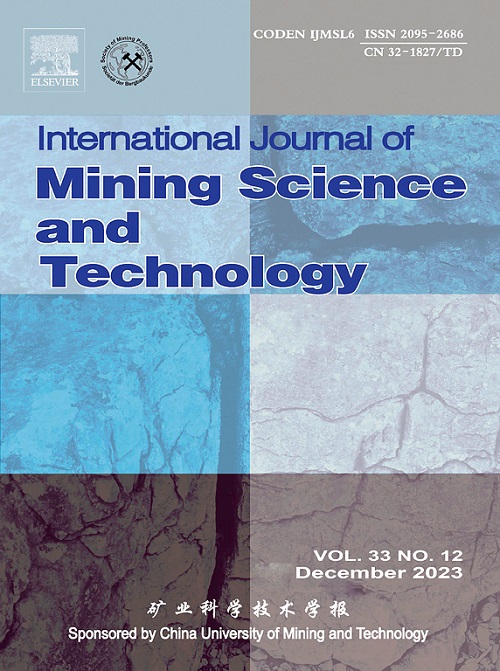scco2削弱煤完整性的时间演化:化学-流体-力学耦合和地质封存意义
IF 13.7
1区 工程技术
Q1 MINING & MINERAL PROCESSING
International Journal of Mining Science and Technology
Pub Date : 2025-06-01
DOI:10.1016/j.ijmst.2025.05.006
引用次数: 0
摘要
二氧化碳的地质封存对深度脱碳至关重要,但煤储层的地质力学稳定性仍然是一个重大挑战。本研究结合纳米压痕、XRD/SEM-EDS化学物理表征和4D CT可视化技术,研究了ScCO2注入对烟煤的时间演化力学降解。结果表明:ScCO2处理4 d后,峰值荷载下的载荷-位移变形增加50.47% ~ 80.99%,蠕变深度增加26.92% ~ 76.17%,弹性模量损失55.01% ~ 63.38%,硬度降低52.83% ~ 74.81%;降解表现为两相动力学,其特征是表面驱动的快速弱化(0-2 d),随后是稳定的基质尺度孔隙均匀化(2-4 d)。ScCO2优先溶解碳酸盐矿物(白云岩),推动孔隙网络扩张和界面脱粘,而硅酸盐矿物抑制溶解,但促进结构均质化。这些地球化学-力学耦合作用降低了煤的力学非均质性,改变了煤的破坏模式。研究结果为储层稳定性评估建立了预测框架,并为优化CO2增强煤层气采收率提供了可行的见解。本文章由计算机程序翻译,如有差异,请以英文原文为准。
Time-evolution of ScCO2-weakened coal integrity: Chemo-hydromechanical coupling and geological sequestration implications
Geological sequestration of CO2 is critical for deep decarbonization, but the geomechanical stability of coal reservoirs remains a major challenge. This study integrates nanoindentation, XRD/SEM-EDS chemo physical characterization and 4D CT visualization to investigate the time-evolving mechanical degradation of bituminous coals with ScCO2 injection. The main results show that 4 d of ScCO2 treatment caused 50.47%–80.99% increase in load–displacement deformation and 26.92%–76.17% increase in creep depth at peak load, accompanied by 55.01%–63.38% loss in elastic modulus and 52.83%–74.81% reduction in hardness. The degradation exhibited biphasic kinetics, characterized by rapid surface-driven weakening (0–2 d), followed by stabilized matrix-scale pore homogenization (2–4 d). ScCO2 preferentially dissolved carbonate minerals (dolomite), driving pore network expansion and interfacial debonding, while silicate minerals resisted dissolution but promoted structural homogenization. These coupled geochemical-mechanical processes reduced the mechanical heterogeneity of the coal and altered its failure modes. The results establish a predictive framework for reservoir stability assessment and provide actionable insights for optimizing CO2 enhanced coalbed methane recovery.
求助全文
通过发布文献求助,成功后即可免费获取论文全文。
去求助
来源期刊

International Journal of Mining Science and Technology
Earth and Planetary Sciences-Geotechnical Engineering and Engineering Geology
CiteScore
19.10
自引率
11.90%
发文量
2541
审稿时长
44 days
期刊介绍:
The International Journal of Mining Science and Technology, founded in 1990 as the Journal of China University of Mining and Technology, is a monthly English-language journal. It publishes original research papers and high-quality reviews that explore the latest advancements in theories, methodologies, and applications within the realm of mining sciences and technologies. The journal serves as an international exchange forum for readers and authors worldwide involved in mining sciences and technologies. All papers undergo a peer-review process and meticulous editing by specialists and authorities, with the entire submission-to-publication process conducted electronically.
 求助内容:
求助内容: 应助结果提醒方式:
应助结果提醒方式:


